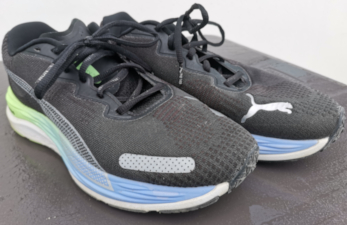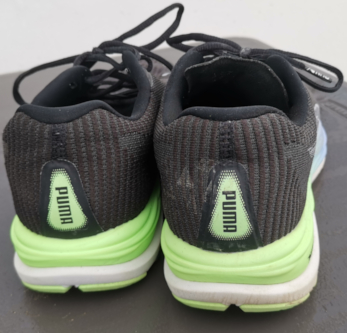After running 100 miles in the PUMA Velocity NITRO 2, my overall experience has significantly improved compared to the first mile. The shoe’s durability, bouncy NITRO cushioning, and breathable upper materials have truly enhanced my enjoyment of running as I continue to use it.
The outsole’s PUMAGRIP technology stands out for its exceptional grip that quickly releases during take-off. Among all the running shoes I’ve tested, the PUMAGRIP is my preferred technology for enhanced ground traction. Its performance shines on wet and uneven surfaces, consistently delivering in wet conditions.

The Velocity shoe may not have the best grip compared to the Deviate NITRO 2, which I find to be more grippy. Additionally, the mesh upper of the Velocity feels less durable and plasticky when compared to the higher-quality mesh upper of the Deviate NITRO 2. While the shoe adapts well to faster speeds, it may be most suitable for easy runs.
The Velocity’s shoelace appears traditional in contrast to the Deviate’s modern lacing system, enhancing its secure fit. The Deviate boasts a more attractive design that complements high-end athletic attire seamlessly.

PUMA Velocity NITRO 2 Fit
Despite being a neutral running shoe, the Velocity NITRO 2 provides a similar fit to the Nike Structure 24 but offers superior ankle support. Moreover, the toe box in the Velocity is more spacious than the Structure 24, easily accommodating super-wide feet. Although I have slightly wide feet and desire a snugger upper for improved multidirectional control, the toe box’s generous size also stands out. Nonetheless, I find running in this wide upper quite comfortable.
Despite being a neutral shoe, the Velocity provides additional stability, which I prefer over the Deviate NITRO 2 that doesn’t support my flat feet. I use the Velocity for my long runs even though it weighs the same as the Structure 24.
The Nike Structure 24 appears to feature a denser upper material than the Velocity NITRO 2, resulting in less breathability. This, in turn, causes discomfort during extended runs. But unlike Structure 24, it lacks the medial support typical of a neutral running shoe.

PUMA Velocity NITRO 2 First Mile
Upon your initial mile, this shoe will offer a standard running experience without any exceptional sensations, which is desirable as a quality running shoe should feel natural during your first run.
The NITRO cushioning offers a soft and bouncy feel, though it lacks the aggressive propulsion of Nike Zoom Air technology. I appreciate Zoom Air’s support during long runs. While NITRO provides great energy return, it requires more effort to move forward compared to Zoom Air. However, I enjoy the gentle impact NITRO has on my leg muscles.
Upon initial contact with the ground, you’ll notice that the PUMAGRIP technology significantly enhances the grip compared to typical outsoles. The wide mesh upper offers a comfortable fit around the forefoot while providing secure support for the ankle, ensuring proper alignment of the rearfoot and enhancing overall stability.
The shoe offers decent breathability, although not on par with the Deviate NITRO 2, allowing for comfortable long-distance running without excessive heat build-up. That said, the Velocity’s upper material is notably denser compared to the Deviate.

Final Thoughts
The Velocity NITRO 2 is among my preferred running sneakers due to its softness, bounce, grip, and longevity. I’ve logged more than a hundred miles in this pair, yet it remains pristine without any visible wear, assuring me it can easily handle over 500 miles.
It will be great if PUMA improves the upper material in the next version, as the quality of the Velocity seems lacking compared to the Deviate NITRO 2. Despite the cost disparity, it appears that I invested more in the Velocity’s materials. In reality, On Running footwear offers superior quality within a comparable price bracket. I am willing to pay extra for improved material quality.
You may also like our reviews of:

